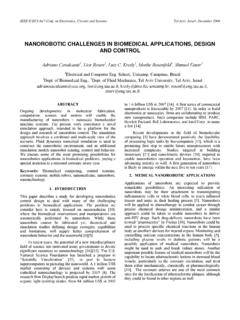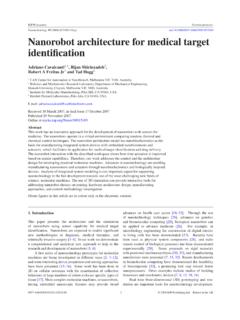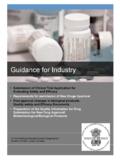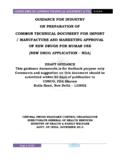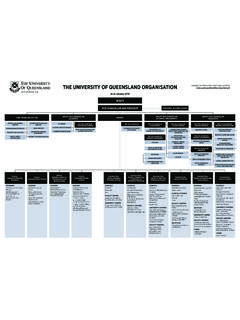Transcription of 40DA3D2C-1E0D-08E12C - Nanorobotics
1 1 Copyright #### by ASME DETC2004 ASME Design Engineering Technical Conferences 28th Biennial Mechanisms and Robotics Conference Salt Lake City, Utah, USA, September 28 to October 2, 2004 DETC2004-57031 Nanorobotics CONTROL DESIGN: A PRACTICAL APPROACH TUTORIAL Adriano Cavalcanti*, Robert A. Freitas Jr.**, Luiz C. Kretly* *Electrical and Computer Engineering School, Unicamp, Campinas SP 13083-970 Brazil **Institute for Molecular Manufacturing, Palo Alto CA 94022 USA ABSTRACT The authors present a new approach using genetic algorithms, neural networks and Nanorobotics concepts applied to the problem of control design for nanoassembly automation and its application in medicine.
2 As a practical approach to validate the proposed design, we have elaborated and simulated a virtual environment focused on control automation for Nanorobotics teams that exhibit collective behavior. This collective behavior is a suitable way to perform a large range of tasks and positional assembly manipulation in a complex 3D workspace. We emphasize the application of such techniques as a feasible approach for the investigation of Nanorobotics system design in nanomedicine. Theoretical and practical analyses of control modelling is one important aspect that will enable rapid development in the emerging field of nanotechnology.
3 Keywords: Biomedical computing, control systems, genetic algorithms, mobile robots, nanomedicine, nanorobots, nanotechnology, neural networks, virtual reality. 1. INTRODUCTION Following the first steps toward molecular manufacturing in the 80 s and 90 s in the sense of nanoscale building blocks, we now face more complex challenges in achieving the next generation of nanotechnology advances, in the sense of building bionanoelectronics and molecular machines. This paper presents the simulation of mobile multi-robot teams operating at atomic scales to perform biomolecular assembly manipulation for nanomedicine [18].
4 In such a virtual nanoworld, the teams must cooperate with each other in order to achieve a productive result in assembling biomolecules into larger biomolecules. The assembled biomolecules must be sequentially delivered into a set of predefined organ inlets, and the nanorobot teams must also keep the nutritional levels of the larger organism under control [9], [10]. In the emerging era of biomolecular engineering, the development of methodologies that help focus experimental investigations enabling nanoassembly automation is meaningful. The motivation for such study is the fact that new approaches for a better comprehension and visualization of nanoworlds aspects can have a great impact on effective design and on the future development of nanotechnology.
5 One important challenge that has become evident as a vital problem in nanotechnology industrial applications is the automation of atomic-scale manipulation. The starting point of nanotechnology to achieve the main goal of building systems at the nanoscale is the development of control automation for molecular machine systems. Such systems are expected to enable the massively parallel manufacture of nanodevice building blocks. Governments all around the world are directing significant resources toward the fast development of nanotechnology [62], [54]. In Germany, the Federal Ministry of Education and Research has announced 50 million Euros to be invested in the years 2002-2006 in research and development on nanotechnology [50].
6 The National Science Foundation has launched a program in Scientific Visualization [47] in part to harness supercomputers in picturing the nanoworld. A US$ 1 trillion market consisting of devices and systems with some kind of embedded nanotechnology is projected by 2015 [44], [16]. More specifically, the firm DisplaySearch predicts rapid market growth from US$ 84 million today to $ billion in 2007 [45]. The miniaturization importance for a broaden core of different devices is well known [31], and a first series of commercial nanoproducts has been announced as foreseeable by 2007 [20].
7 To reach the goal of building organic electronics, 2 Copyright #### by ASME firms are forming collaborations and alliances that bring together new nanoproducts through the joint efforts of companies such as IBM, Motorola, Philips Electronics, Xerox/PARC, Hewlett-Packard, Dow Chemical, Bell Laboratories, and Intel Corp., among others [20], [45]. For such goals, new methodologies and theories to explore the nanoworld are the key technology [14]. Building patterns and manipulating atoms with the use of SPMs as in Atomic Force Microscopy (AFM) and Scanning Tunneling Microscopy (STM) has been demonstrated with satisfactory success as a promising approach for the construction of nanoelectromechanical systems (NEMS) with 3D precision at nm resolution [52].
8 However, such manual manipulations require much time, and even for a repetitive task these manipulations tend to produce imprecise work when performed manually for a large number of molecules. Practical approaches for nano planning systems have been presented as a first step towards automating assembly tasks in Nanorobotics , as for example in 2D positional assembly automation [38]. Initial uses of nanorobots to health care are likely to emerge within the next ten years [51] with potentially broad biomedical applications [56], [41]. The use of artificial intelligence as the appropriate means to enable some aspects of intelligent behavior in the control of nanorobots during molecular manufacturing automation has been discussed in the nano community [60].
9 The use of concepts derived from collective robotics and behavior control was investigated for nanomedicine dealing with a common goal to destroy malignant tissues in the human body [36]. More recent work is progressing towards the development of a Nanorobotics autonomous system capable of performing 200,000 accurate measurements per second at atomic scale [39]. An Intel prototype 90-nm process facility has already produced a fully functional 52 Mb SRAM with transistor gate lengths of 50 nm and SRAM cell sizes of just 21m , or roughly half the cell size of today s most advanced SRAMs [20].
10 This downscaling will continue, according to the Semiconductor Industry Association s roadmap. By 2016, high-performance ICs will contain more than billion transistors in a 280 mm2 area - more than 25 times as many as on today s chips built with 130-nm feature sizes [20]. A useful starting point for achieving the main goal of building nanoscale devices is the development of generalized automation control for molecular machine systems which could enable a manufacturing schedule for positional nanoassembly manipulation. In this paper we consider a more specialized scheduling problem with a focus on nanomedicine: describing in a detailed fashion the nanorobot control design and the surrounding virtual workspace modelling that is required for the main kinematics aspects of a physically-based nanoworld simulation.
